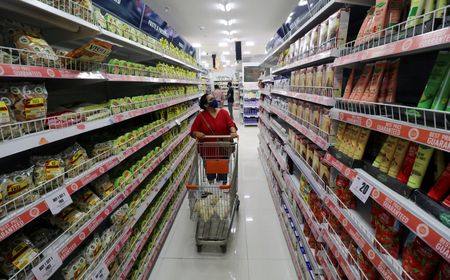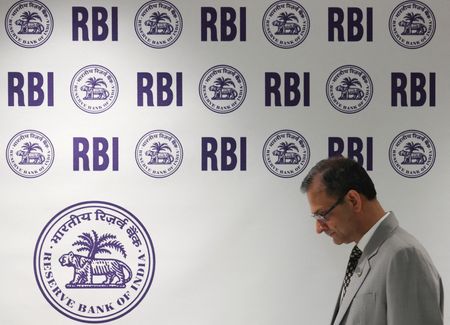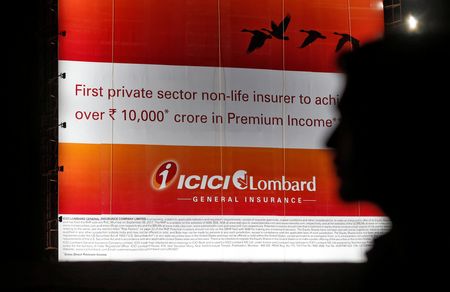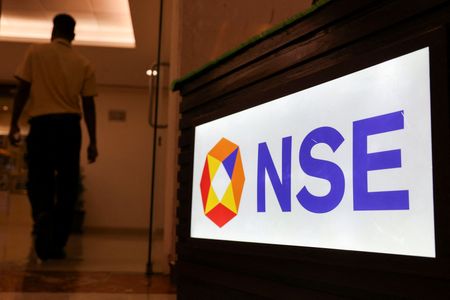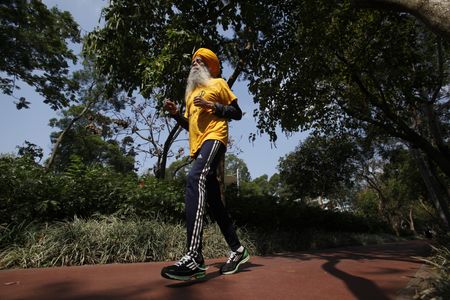By Swati Bhat
MUMBAI (Reuters) -A slump in India’s retail inflation to six-year lows and a likely drop to a record low in July is prompting calls for at least one more interest rate cut this year, with many analysts saying the sharp disinflation is also a sign of weakening demand.
The drop in June headline inflation is accompanied by low core inflation, which, excluding gold, silver and fuel prices, remains below 4%, suggesting softer underlying consumption which may need more support from monetary policy, analysts say.
The Reserve Bank of India cut interest rates by a deeper-than-expected 50 basis points (bps) at its last policy review in June but changed its stance to ‘neutral’, signalling limited room to cut rates further.
After Monday’s surprise inflation reading, however, analysts and markets are reflecting the rising possibility of more easing. Swap rates moved lower on Monday and Tuesday, suggesting bets on at least one more rate reduction ahead.
Radhika Rao, an economist with DBS Bank, expects another 50 bps of cuts in the current easing cycle.
“Considering the softness in incoming activity indicators (e.g. production, credit growth, auto sales), and below-projected inflation in the first half of fiscal 2026, the RBI monetary policy committee will be inclined to ease rates further,” Rao said without giving a specific timeframe.
The RBI’s next policy review is in early August, though analysts think it will wait for more data and clarity on the global trade war front before likely moving in September or October.
Demand weakness is slowly starting to show up in indicators across sectors like autos and real estate.
Car sales to dealers fell to a 18-month low in June, data showed on Tuesday. Meanwhile, home sales in India’s top seven cities fell 20% in the April-June quarter, real estate consultancy firm Anarock said in a report last month.
“High frequency indicators continue to show moderation in urban consumption and tentative private capex,” said Gaura Sen Gupta, chief economist at IDFC First Bank, who expects one more rate cut from the central bank in October or December.
RATE HINTS
India’s central bank expects inflation for the full year to be below 3.7%, Governor Sanjay Malhotra told CNBC TV-18 earlier in the day, adding that the monetary policy committee (MPC) will look at the inflation outlook, and not just current data, while deciding on further rate moves.
In an interview with the Business Standard following the June policy decision, he had said room may open up if inflation runs lower than its projections.
“With the RBI policy stance being at ‘neutral’, it is difficult to think of a deep rate cut cycle from here,” said Samiran Chakraborty, economist at Citi. “But we think the MPC will utilise the space that has opened because of the softer-than-expected CPI prints.”
In the April-June quarter, inflation averaged 2.7%, below the RBI’s forecast of 2.9%.
Citi expects July’s inflation rate to fall to a record low of 1.1% and average inflation in the financial year 2025-26 of 3.2%, the lowest since 1990.
URBAN DEMAND LAGGING
Urban consumption in India began to slow last year, which economists attribute to weak wage growth and depleted household savings.
Rural demand showed a recovery after a strong monsoon last year, but the pick-up has been inconsistent.
Sales of two-wheel vehicles, one of the proxies for rural demand, saw a modest 4.7% increase in June but fell 12.5% month-on-month.
Private investment has remained sluggish as well. Capacity utilisation has been stuck at around 75–76% for over a year — below the threshold that typically triggers new capital expenditures, economists said.
Madhavi Arora, an economist with Emkay Global, said investment is unlikely to pick up immediately amid global trade uncertainties and a murky domestic demand outlook.
“Broadly, the India growth story is stuck at around 6.0%-6.5% kind of range with the story being of missing private economic agents in India,” she added.
Government capex has picked up in the first quarter of fiscal 2026. But with the government already having announced tax cuts in the budget, most economists said the ability to provide further stimulus is limited from the fiscal side.
“The space for fiscal policy to further support growth is limited with downside risk to tax collection and nominal GDP growth. Hence, monetary policy will have to continue to do the heavy lifting to support growth,” IDFC’s Sen Gupta said.
(Reporting by Swati Bhat; Editing by Kim Coghill)

